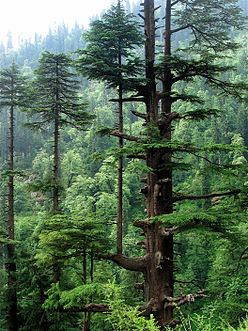Habitat loss 62.318% Bird species 315 Protected 6.2% | Area 39,700 km² Mammal species 102 | |
 | ||
Borders Northwestern Himalayan alpine shrub and meadowsWestern Himalayan alpine shrub and meadowsWestern Himalayan broadleaf forestsHimalayan subtropical pine forestsBaluchistan xeric woodlands Biome Temperate coniferous forest | ||
The Western Himalayan subalpine conifer forests is a temperate coniferous forests ecoregion of the middle and upper elevations of the western Middle Himalayas of Nepal, India, and Pakistan.
Contents
Setting
The ecoregion forms a belt of coniferous forest covering 39,700 square kilometres (15,300 sq mi) on elevations between 3,000 and 3,500 metres (9,800 and 11,500 ft). It extends west from the Gandaki River in Nepal, through the Indian states of Uttarakhand and Himachal Pradesh, and into Jammu and Kashmir eastern Pakistan. This belt of conifers is the highest expanse of woodland to be found on the slopes of the Himalayas, treeless alpine scrub lying just above its ecotopic frontier. It is a valuable ecosystem as many Himalayan birds and animals migrate seasonally up and down the mountains spending part of the year in the conifer forests, so conservation is a high priority.
This ecoregion is drier than the Eastern Himalayan subalpine conifer forests, which receive more moisture from the Bay of Bengal monsoon.
Flora
Several distinct forest types are found in this ecoregion. Fir trees (Abies spectabilis) in places grow in nearly pure stands. In other areas they mix with oaks (Quercus semecarpifolia). Rhododendron campanulatum, Abies spectabilis, and birch (Betula utilis) form another common assemblage. Elsewhere mixed-conifer forests are made up of Abies spectabilis, blue pine (Pinus wallichiana) and spruce (Picea smithiana). Cupressus torulosa and Cedrus deodara are also found here. A recently published major new monograph, Conifers Around the World, treats the high-level western Himalayan fir tree as Abies gamblei (apparently, A. spectabilis does not reach this region!)
Fauna
This ecoregion is home to some fifty-eight species of mammals. Important inhabitants include the brown bear and threatened or endangered species such as Himalayan serow, Himalayan tahr, and the markhor goat, the national symbol of Pakistan. The only endemic mammal is a rodent, the murree vole (Hyperacrius wynnei).
About 285 species of birds have been recorded in this ecoregion, including 9 endemic species and a number of birds that are sensitive to habitat disturbance and therefore likely to be vulnerable to further forest clearance. These include the Koklass pheasant (Pucrasia macrolopha), western tragopan (Tragopan melanocephalus), and the Himalayan monal (Lophophorus impejanus).
Threats and conservation
Despite being relatively thinly populated some seventy percent of the conifer forest has been cleared or degraded, partly to make way for terrace cultivation. However it still contains some of the least disturbed forests in the western Himalayas. Protected areas that contain areas of conifer forest include Great Himalayan National Park and Rupi Bhabha Sanctuary in Himachal Pradesh, Kishtwar National Park in Jammu and Kashmir, Gangotri National Park and Govind Pashu Vihar Wildlife Sanctuary in Uttarakhand, all in India, and Royal Dhorpatan Hunting Reserve in Nepal. A particular threat comes from disturbance of nesting birds during the collection of morel mushrooms in spring.
